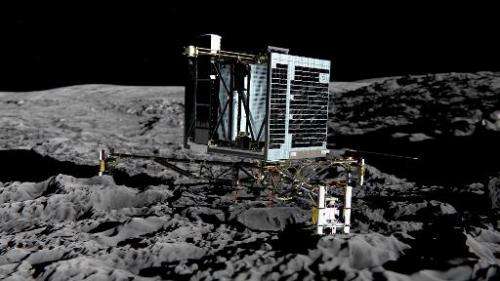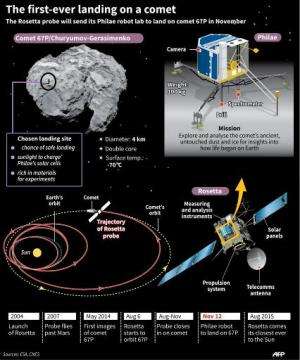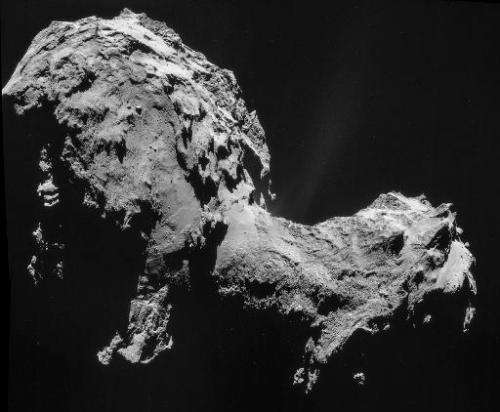Europe set to make space history with comet landing

One of the biggest gambles in space history comes to a climax on Wednesday when Europe attempts to make the first-ever landing on a comet.
Speeding towards the Sun at 65,000 kilometres (40,600 miles) per hour, a lab called Philae will detach from its mothership Rosetta, heading for a deep-space rendezvous laden with risk.
The 100-kilogram (220-pound) probe will seek out a minuscule landing site on the treacherous surface of an object darker than coal, half a billion kilometres (300 million miles) from home.
"It's not going to be an easy business," was the understated prediction of Philippe Gaudon of France's National Centre for Space (CNES) as the mission prepared to enter countdown mode.
The stakes facing Rosetta managers in Darmstadt, Germany are daunting as the 1.3-billion-euro ($1.61-billion) project reaches a peak.
Two decades of work have been poured into what could be a crowning moment in space exploration.
The goal: the first laboratory research into the primeval matter of the Solar System—ancient ice and dust that, some experts believe, may have helped to sow life on Earth itself.
According to this theory, comets pounded the fledgling Earth 4.6 billion years ago, providing it with complex organic carbon molecules and precious water.
Rosetta has already sent home fascinating data on the comet, but Philae will provide the first boots-on-the-ground assessment, using 10 instruments to study the comet's physical and chemical composition.
Like Rosetta, it will wield a mass spectrometer, a high-tech tool to analyse a sample's chemical signature, aimed at drawing up a complete carbon inventory.
The showstopper find would be molecules known as left-handed amino acids, the European Space Agency (ESA) says.
"These are the 'bricks' with which all proteins on Earth are built," it says.

Nail-biting
But getting Philae into position will be a white-knuckle ride.
After its launch in 2004, Rosetta spent 10 years zig-zagging around Earth and Mars, using the planets' gravitational pull as a slingshot to build up speed to reach its prey, Comet 67P/Churyumov-Gerasimenko.
But when Rosetta finally caught up with it in August, it witnessed a sight that caused despondency back on Earth.
Far from being a simple potato shape, "67P" turned out be two gnarled lobes about four km across joined by a narrow neck.
It looked like an super-dark rubber duck, ravaged by aeons in orbit, turning slowly in space.
Its surface was a nightmare of crests and gullies, studded with hundreds of rocks as high as 50 metres (165 feet) and wicked slopes with an incline greater than 30 degrees.
This was a huge, unexpected problem, said Francis Rocard, a French astrophysicist.
"It took a billion calculations to find a decent landing site"—one offering a fair chance that Philae could survive and meet scientific goals, he said.
If final "go/no-go" assessments give the green light, Philae will separate from Rosetta about 20 kilometres (12 miles) from the comet at 0835 GMT on Wednesday.

"Then it's a very gentle freefall for the next seven hours," said Sylvain Lodiot, in charge of flight operations.
After that comes the hard bit.
No one knows what a comet's surface is like.
Is it hard and crusty, like a shell? Crumbly? Slippery? Is it brittle—will it crack, causing Philae to sink into some fudgy or spongey substance below?
Seeking to cover all the possibilities, Philae's designers have equipped the lander with three outstretched legs designed to dampen the impact.
When the lab touches down, it will fire two harpoons to secure it to what—hopefully—will be a robust surface, while a thruster on top of the lander will fire to cancel out bounce. Ice screws in the lander feet will deploy for extra grip.
The chances of success? "Seventy percent," said Gaudon, admitting to days of doubt that the chances were much better than one in two.
"We need to be lucky," added Andrea Accomazzo, flight director.
And only then can Philae start its real mission of analysing the makeup of the comet.
Batteries will be enough to keep the probe going for 60 hours, but recharging from sunlight "could keep us going until March," said Rocard.
Stage set for comet drama
The stage is set for the most dramatic scene yet in the epic voyage of Europe's space probe Rosetta, whose payload, Philae, will make the first landing on a comet next Wednesday:
THE SET
The historic attempt to land on a comet will take place more than 500 million kilometres (310 million miles) from Earth.
Approved in 1993, the production cost about 1.3 billion euro ($1.61 billion), involving around 200 backstage staff and 50 companies from 14 European countries and the United States.
THE CAST
ROSETTA, a three-tonne aluminium box of 2.8 x 2.1 x 2.0 metres (9.2 x 6.9 x 6.5 feet) with two 14m solar arrays.
The orbiter carries 11 instruments to map the comet's surface and analyse its atmosphere, gases in its tail, the dust it emits and its subsurface temperature, mass, density and gravity.
Rosetta got its name from the stone that led to the deciphering in the 19th century of Egyptian hieroglyphics.
PHILAE, a 100-kg (220-pound) lab named after an obelisk on the Nile whose inscriptions were a key to the Rosetta stone.
It carries 10 instruments, including X-ray detectors to scan the comet's composition, micro-cameras for panoramic shots and radiowave probes of the comet's internal structure.
Philae has a drill to take subsurface comet samples from a depth of about 20 centimetres (eight inches) for onboard chemical analysis.
It will relay the results of its experiments to Rosetta, to be passed to Earth.
Its battery is charged to give it around 60 hours' operating time, but the probe could continue its work until March if the sunlight and temperature are right for its solar panels.
67P/CHURYUMOV-GERASIMENKO, a pitch-black 4-km comet named after two Ukrainian astronomers who first spotted it in 1969.
The first part of its moniker refers to the fact that it was the 67th "periodic comet" discovered—these orbit the Sun in less than 200 years.
The comet comprises two lobes joined by a narrow "neck", giving it the silhouette of a toy bath duck.
If it could be brought back to Earth, it would smell like a bad mix of rotten eggs and horse urine, among other things, tests of its escaping gases suggest.
The prime landing site, dubbed Agilkia after an island on the Nile, is on the smaller lobe roughly where the duck's forehead would be.
THE WARM-UP
Launched on March 2, 2004, Rosetta was placed in a two-and-a-half-year hibernation in June 2011 to limit power and fuel consumption on its six-billion-kilometre (3.7-billion-mile) journey.
Because there was no rocket powerful enough to place it directly into orbit, the craft was designed to be catapulted around the Solar System with gravity boosts from Mars and Earth on four flybys between 2005 and 2009.
Awoken from slumber in January this year, Rosetta arrived at the comet on August 6.
AND NOW, SHOWTIME
Once Rosetta is aligned correctly, Philae is meant to self-eject at 0835 GMT from a distance of some 20 km and unfold its three legs for what will hopefully be a gentle touchdown.
The self-adjusting landing gear is meant to ensure Philae stays upright, even if it lands on a slope. It will avoid escaping the comet's weak gravity by shooting two harpoons into its surface and using screws in its feet to secure itself to the surface.
If all goes well, signals giving confirmation of the landing will arrive on Earth at 1602 GMT.
Highlights of unmanned space exploration
In 1942, the Nazis' V-2 rocket became the first man-made object to touch the fringes of space.
Since then, humankind has sent scouts around the Solar System to explore its central star, planets and other bodies.
If all goes well, another milestone will be reached next Wednesday when Europe lands a robot lab on a comet.
Here are other firsts in unmanned space exploration:
SPUTNIK 1
The first artificial satellite was launched by the Soviet Union on October 4, 1957, ushering in the space age and the Cold War tussle for the cosmos.
The beachball-sized, aluminium sphere took 98 minutes to orbit the Earth, and sent the first-ever message received from space.
Another pioneering satellite is NASA's Hubble Space Telescope, placed in near-Earth orbit in 1990, which has provided dazzling pictures of objects in deep space.
LUNA 2
Another Soviet record, this probe was the first man-made craft to reach another celestial body, crashing into the Moon in 1959 and scattering Soviet pennants on its surface.
Its successor Luna 3 sent back the first-ever picture of the far side of the Moon later that same year, and Luna 9 made the first soft landing on the Moon in 1966.
VENERA 3
This Soviet lander was the first to touch the surface of another planet—Venus, in 1966. A landing capsule was released successfully, but contact with it was lost and no scientific data was returned.
The first soft landing on a planet, also Venus, was achieved by Venera 7, four years later.
Venera 7 transmitted the first signals from another planet, and revealed that Venus, far from being a home from home, would be lethal for humans.
PIONEER 10
In 1973, the NASA spacecraft carried out the first flyby of Jupiter, swinging past the biggest planet of the Solar System at a distance of 130,000 km (80,000 miles).
In 1983, it became the first spacecraft to travel past the orbit of Neptune, the outermost of the acknowledged planets.
Pioneer 10 and its sister, Pioneer 11, carry aluminium plaques with the drawing of a man and a woman along with information indicating where the probes came from.
VOYAGER 1 AND 2
Launched in 1977 to explore further afield than ever before, Voyager 1 returned detailed photographs of Jupiter and Saturn before becoming, in 1998, the most distant human-made object.
In 2012, it entered interstellar space, the region between the stars.
Like its companion Voyager 2, which in 1986 became the first spacecraft to fly past Uranus, the vessel carries a 30-cm gold-plated copper disc.
The record includes a "greeting to the universe" in 60 languages, music and 115 images of Earth—complete with a stylus with which to play it.
GALILEO
Launched in 1989, this NASA mission became the first to go into orbit around a gas giant planet, Jupiter, in 1995. It carried a range of science instruments and an atmospheric probe.
It found evidence for liquid water oceans under the icy surface of Jupiter's moon Europa.
MARS PATHFINDER
An innovative airbag cocoon cushioned the landing of this spacecraft on the Red Planet in 1997, from which emerged the first-ever wheeled rover, dubbed Sojourner, to explore another planet.
NEAR Shoemaker
The first landing on an asteroid happened about 355 million km from Earth in 2001, touching down at a gentle 1.5 metres per second.
Four years later, Japan's Hayabusa spacecraft was the first to land on, take a sample, and take off from an asteroid, Itokawa, and send the dust it collected back to Earth.
CASSINI
A joint project of NASA, the European Space Agency (ESA) and the Italian ASI, this explorer in 2004 became the first to enter the orbit of Saturn, from where it has closely studied the giant planet's magnificent rings.
In 2005, Cassini sent down a probe, Huygens, to Saturn's largest moon Titan—a strange world with lakes of liquid methane.
STARDUST
In 2004, this NASA mission was the first to collect samples from the wake of a comet, dubbed 81P/Wild, as it shaved by at a distance 236 km. The particles were returned to Earth in a capsule in January 2006 for analysis.
© 2014 AFP





















